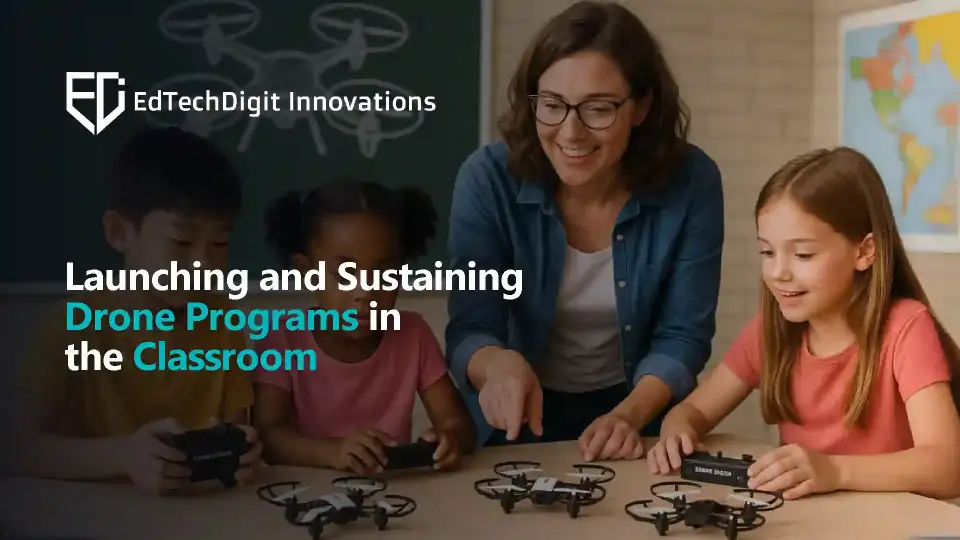Establishing a drone program is an exciting first step for schools, but the real challenge is keeping it up year after year. By 2030, the commercial drone market is anticipated to reach $54.6 billion, driven by expanding enterprise applications and a 7.7% Compound Annual Growth Rate (CAGR), according to Drone Industry Insights (grandviewresearch.com). Due to the rapidly increasing demand for drone skills, schools must prepare their students for this future.
A sustainable program requires more than just buying drones; it also requires curriculum integration, teacher training, industry partnerships, safe and scalable practices, and continuous student involvement. When schools are designed with these pillars in mind, drone programs not only survive but thrive, providing students with the opportunities and skills they need to thrive in the workforce of the future.
Start with Real-World Relevance
Showing drones in action outside of the classroom is the best way to boost student engagement, according to experts. Today, drones are employed in soil analysis and crop monitoring in agriculture.
- Site surveys and structural examinations are part of construction.
- Search-and-rescue activities are part of emergency response.
- Environmental science includes mapping forests and monitoring wildlife.
Students realize sustainable STEM education has a purpose beyond theory when they witness drones being used to address issues that are important to them, such as public safety, urban planning, and climate change.
Invest in Teacher Training and Long-Term Commitment
The people in charge of a sustainable drone program make or break it.
- Schools should use accredited drone training facilities to offer teachers professional development and to increase student engagement.
- Establish a "train-the-trainer" approach in which new hires are coached by early adopters.
- Assigning instructors or coaches who are committed to the program will promote long-term ownership.
Having a committed teacher or coach who remains committed over time is often the difference between a drone program that succeeds and one that fails in sustainable STEM education.
Choose the Right Equipment for the Right Stage
Buying drones can be expensive, but sustainability doesn’t mean purchasing the most advanced models.
- Avoid ultra-cheap drones: They break easily and frustrate students.
- Avoid overspending: Industrial drones are unnecessary for beginners.
- Best practice: Start with educational drones, safe, durable, and certification-free.
As students’ progress, schools can upgrade to advanced models through curriculum integration, ensuring each year offers a new challenge and skill-building opportunity.
Keep Students Engaged Beyond Year One
One of the most common pitfalls is stagnation, students doing the same drone exercises year after year. To avoid this:
- Add new modules each year (e.g., Year 1: basics of flight; Year 2: coding autonomous missions; Year 3: data analytics from drone imagery).
- Introduce drone competitions, regional, national, or global, where students solve challenges with drones, while also maintaining safety and compliance.
- Expand into cross-disciplinary projects, linking drones to environmental studies, geography, or digital media.
Build Partnerships with Industry and Community
Industry partnerships ensure relevance, funding, and real-world exposure. Schools can collaborate with:
- Local businesses that already use drones (construction firms, agriculture cooperatives, logistics providers).
- Government agencies involved in urban planning or environmental conservation.
- Universities and research labs that can provide mentorship and internships.
Secure Funding Beyond One-Time Grants
Funding challenges often stall drone programs. Schools should look beyond drone-specific grants and consider:
- STEM or EdTech grants from government agencies.
- CSR initiatives from tech giants like Microsoft, IBM, and Google.
- Community sponsorships from local industries.
Prioritize Ethics, Safety and Compliance
A truly sustainable program must address safety and compliance. Schools should:
- Follow national aviation regulations like the FAA in the USA.
- Establish strict classroom safety protocols.
- Teach students ethical drone use, including privacy, data handling, and respectful flying.
This not only builds trust with parents and administrators but also prepares students for professional drone certification and real-world jobs through curriculum integration.
Measure Outcomes and Scale Thoughtfully
Finally, sustainability means constant evaluation. Schools should track:
- Student participation rates and retention.
- Improvements in sustainable STEM education performance.
- Student interest in drone-related careers or further studies.
- Success in drone competitions or community projects.
With data, schools can refine programs, justify funding, boost student engagement, and expand offerings to more grade levels.
Conclusion: A Long-Term Flight Plan
Launching a drone program is not just about buying drones; it’s about creating a framework for continuous learning. When schools connect lessons to real-world applications, invest in teachers, provide progressive challenges, and collaborate with industry, they ensure the program doesn’t end with one batch of students but becomes a sustainable pipeline of future-ready innovators and technology leaders.
As we move deeper, schools that adopt this structured, future-focused approach will not only spark student curiosity but also equip them with the skills to lead industries being reshaped by drones, autonomous systems, and emerging technologies, preparing them to define the next era of innovation.

